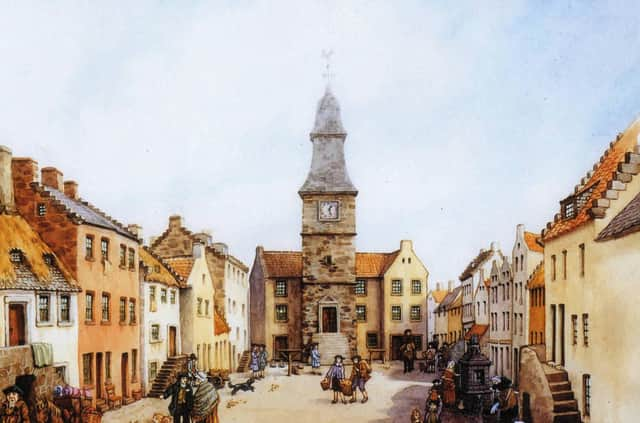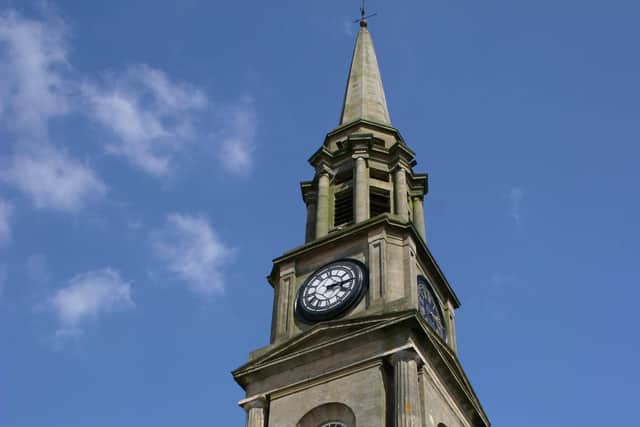Looking back with Ian Scott on the history of the Falkirk Steeple


This week, after a Covid delay, it opens its doors as a Heritage Centre run by Falkirk Local History Society on behalf of Falkirk Council.
The building work on the current building was finally completed in June 1814 and the keys were handed over by Henry Taylor the builder to Thomas Johnston, Praeses’ (or chairman) of the famous Stentmasters.
Advertisement
Hide AdAdvertisement
Hide AdIt was this body of self-elected rulers of the burgh, whose main skill seemed to be in spending money they didn’t have, who decided that the old steeple demolished ten years earlier should be replaced by the fine building we have today.


We don’t know all that much about Falkirk’s first steeple which was probably built in the 1580s and may have stood near the junction of Manor Street and Kirk Wynd. We do know that by 1697 it was in a ruinous state and was replaced that year by a new building in the centre of High Street attached to the front of the town tolbooth.
It had a clock, a weather cock and a bell gifted by the Earl of Callendar James Livingston, which was transferred to the present steeple in 1814.
The town’s second steeple was designed as a local symbol of Falkirk’s civic pride with the aim of being seen from far and wide.
Advertisement
Hide AdAdvertisement
Hide AdIn 1801 William Glen of Forganhall rented the ruined tolbooth next to the steeple and began to dig in the cellars. Unfortunately, he disturbed the foundations so that the steeple began to lean over like its famous equivalent in Pisa. Down it came, and after lengthy legal wrangling the Stentmaster’s great project got under way.
In 1812 a public appeal was launched to raise the £1460 required and David Hamilton, the celebrated Glasgow architect, came up with the handsome classical design which we admire so much. Inside, however it was a bit grimmer with two cells above the jailer’s room and the shop, which was rented out to a local shoemaker. The next floor contained a meeting room with striking views along the High Street.
Building work began in 1813 and by June 1814 the new 140 foot steeple was complete.
A second bell, much bigger than the Earl of Livingston’s gift was commissioned from Thomas Mears’ London foundry which bears the message May Falkirk Flourish and still rings out over the town today. Falkirk’s leading clockmaker John Russell was given the job of building a completely new clock which survived until the unfortunate lightning strike in 1927. Finally a fine new brass weather cock was mounted on the top of the spire and everything was ready.
Advertisement
Hide AdAdvertisement
Hide AdThe happy Stentmasters no doubt basked in the glory of the moment despite the fact that only £450 had been collected and the town debt increased.
The 1927 lightning strike damaged the top 40 feet of the building with falling masonry injuring several people and covering a large area, damaging nearby buildings. By 1928 the steeple had been repaired and, outwardly, it has changed little since – apart from the occasional facelift.
In 1973 the ground floor shop was converted into an information centre before being given a new use in the 1980s – as the local box office. The box office closed in 2016 and more recently the steeple was only open to locals and visitors annually in September for Doors Open Day tours.
The steeple, which marked its 200th anniversary in 2014 with a whole host of celebrations, underwent extensive specialist restoration work in 2016 as part of the £5.5 million Falkirk Townscape Heritage Initiative (THI) funded by the Heritage Lottery fund, Historic Scotland, Falkirk Council and Falkirk Bid in partnership with Falkirk Community Trust.
Advertisement
Hide AdAdvertisement
Hide AdThe work included repairs to stonework, the clock, bells, windows and the weather vane.
Overlooking countless local celebrations, the Steeple is still very much a symbol of local pride, used by many local groups in their logos, including Falkirk FC and in the masthead of the Falkirk Herald.